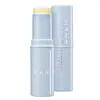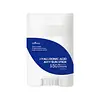What's inside
What's inside
 Key Ingredients
Key Ingredients

 Benefits
Benefits

 Concerns
Concerns

 Ingredients Side-by-side
Ingredients Side-by-side

Butylene Glycol Dicaprylate/Dicaprate
EmollientDimethicone
EmollientSilica
AbrasiveEthylhexyl Methoxycinnamate
UV AbsorberPolyethylene
AbrasiveButyloctyl Salicylate
Skin ConditioningVinyl Dimethicone/Methicone Silsesquioxane Crosspolymer
Diphenylsiloxy Phenyl Trimethicone
Skin ConditioningDicaprylyl Carbonate
EmollientEthylhexyl Salicylate
UV AbsorberCetyl Ethylhexanoate
EmollientTriethylhexanoin
MaskingParaffin
PerfumingDiethylamino Hydroxybenzoyl Hexyl Benzoate
UV FilterBis-Ethylhexyloxyphenol Methoxyphenyl Triazine
Skin ConditioningOctocrylene
UV AbsorberSorbitan Isostearate
EmulsifyingMicrocrystalline Wax
Emulsion StabilisingGlycyrrhiza Uralensis Extract
EmollientCaesalpinia Spinosa Fruit Extract
Skin ProtectingBacillus Ferment
Skin ConditioningCandida/Garcinia Cambogia Ferment
Kappaphycus Alvarezii Extract
Skin ConditioningOryza Sativa Germ Oil
EmollientSchisandra Chinensis Fruit Extract
Skin ConditioningHydrolyzed Collagen
EmollientLithospermum Erythrorhizon Root Extract
Skin ConditioningCurcuma Longa Root Extract
MaskingPhytosteryl/Isostearyl/Cetyl/Stearyl/Behenyl Dimer Dilinoleate
Skin ConditioningHydrogenated Polyisobutene
EmollientEthylhexyl Hydroxystearate
EmollientDisteardimonium Hectorite
StabilisingPropylene Carbonate
SolventCaprylyl Glycol
EmollientGlyceryl Caprylate
EmollientAdenosine
Skin ConditioningAluminum Hydroxide
EmollientTriethoxycaprylylsilane
Tocopherol
AntioxidantWater
Skin ConditioningButylene Glycol
Humectant1,2-Hexanediol
Skin ConditioningSoluble Proteoglycan
Skin ConditioningSodium Dna
Skin ConditioningParfum
MaskingButylparaben
MaskingHexyl Cinnamal
PerfumingBenzyl Salicylate
PerfumingHydroxycitronellal
PerfumingCitronellol
PerfumingAlpha-Isomethyl Ionone
PerfumingLinalool
PerfumingTitanium Dioxide
Cosmetic ColorantCI 77163
Cosmetic ColorantGardenia Florida Fruit Extract
Skin ConditioningButylene Glycol Dicaprylate/Dicaprate, Dimethicone, Silica, Ethylhexyl Methoxycinnamate, Polyethylene, Butyloctyl Salicylate, Vinyl Dimethicone/Methicone Silsesquioxane Crosspolymer, Diphenylsiloxy Phenyl Trimethicone, Dicaprylyl Carbonate, Ethylhexyl Salicylate, Cetyl Ethylhexanoate, Triethylhexanoin, Paraffin, Diethylamino Hydroxybenzoyl Hexyl Benzoate, Bis-Ethylhexyloxyphenol Methoxyphenyl Triazine, Octocrylene, Sorbitan Isostearate, Microcrystalline Wax, Glycyrrhiza Uralensis Extract, Caesalpinia Spinosa Fruit Extract, Bacillus Ferment, Candida/Garcinia Cambogia Ferment, Kappaphycus Alvarezii Extract, Oryza Sativa Germ Oil, Schisandra Chinensis Fruit Extract, Hydrolyzed Collagen, Lithospermum Erythrorhizon Root Extract, Curcuma Longa Root Extract, Phytosteryl/Isostearyl/Cetyl/Stearyl/Behenyl Dimer Dilinoleate, Hydrogenated Polyisobutene, Ethylhexyl Hydroxystearate, Disteardimonium Hectorite, Propylene Carbonate, Caprylyl Glycol, Glyceryl Caprylate, Adenosine, Aluminum Hydroxide, Triethoxycaprylylsilane, Tocopherol, Water, Butylene Glycol, 1,2-Hexanediol, Soluble Proteoglycan, Sodium Dna, Parfum, Butylparaben, Hexyl Cinnamal, Benzyl Salicylate, Hydroxycitronellal, Citronellol, Alpha-Isomethyl Ionone, Linalool, Titanium Dioxide, CI 77163, Gardenia Florida Fruit Extract
Water
Skin ConditioningPolyethylene
AbrasivePropylheptyl Caprylate
EmollientC12-15 Alkyl Benzoate
AntimicrobialHomosalate
Skin ConditioningSilica
AbrasiveEthylhexyl Methoxycinnamate
UV AbsorberNeopentyl Glycol Diheptanoate
EmollientVinyl Dimethicone/Methicone Silsesquioxane Crosspolymer
Ethylhexyl Salicylate
UV AbsorberButylene Glycol
HumectantSynthetic Fluorphlogopite
Niacinamide
SmoothingDiethylamino Hydroxybenzoyl Hexyl Benzoate
UV FilterVinyldimethicone
Bis-Ethylhexyloxyphenol Methoxyphenyl Triazine
Skin ConditioningOzokerite
Emulsion StabilisingPolyglyceryl-4 Diisostearate/Polyhydroxystearate/Sebacate
EmulsifyingPinus Pinaster Bark Extract
AntioxidantBambusa Vulgaris Water
Skin ConditioningMesembryanthemum Crystallinum Extract
HumectantHibiscus Sabdariffa Flower Extract
Skin ConditioningCeramide NP
Skin ConditioningGlycerin
HumectantOlea Europaea Fruit Oil
MaskingLaminaria Japonica Extract
Skin ProtectingUlmus Davidiana Root Extract
Skin ConditioningAloe Barbadensis Leaf Extract
EmollientViola Mandshurica Flower Extract
AntioxidantDioscorea Japonica Root Extract
Skin ConditioningPolyglyceryl-2 Dipolyhydroxystearate
Skin ConditioningPolyurethane-11
Glyceryl Caprylate
EmollientSorbitan Sesquioleate
EmulsifyingSodium Hyaluronate
HumectantAdenosine
Skin ConditioningAstaxanthin
Skin ConditioningPentylene Glycol
Skin ConditioningSodium Acetylated Hyaluronate
HumectantSodium Hyaluronate Crosspolymer
HumectantAscorbyl Propyl Hyaluronate
Skin ConditioningHydroxypropyltrimonium Hyaluronate
Hydrolyzed Sodium Hyaluronate
Skin ConditioningHydrolyzed Hyaluronic Acid
HumectantHyaluronic Acid
HumectantTriethoxycaprylylsilane
Caprylyl Glycol
EmollientEthylhexylglycerin
Skin Conditioning1,2-Hexanediol
Skin ConditioningWater, Polyethylene, Propylheptyl Caprylate, C12-15 Alkyl Benzoate, Homosalate, Silica, Ethylhexyl Methoxycinnamate, Neopentyl Glycol Diheptanoate, Vinyl Dimethicone/Methicone Silsesquioxane Crosspolymer, Ethylhexyl Salicylate, Butylene Glycol, Synthetic Fluorphlogopite, Niacinamide, Diethylamino Hydroxybenzoyl Hexyl Benzoate, Vinyldimethicone, Bis-Ethylhexyloxyphenol Methoxyphenyl Triazine, Ozokerite, Polyglyceryl-4 Diisostearate/Polyhydroxystearate/Sebacate, Pinus Pinaster Bark Extract, Bambusa Vulgaris Water, Mesembryanthemum Crystallinum Extract, Hibiscus Sabdariffa Flower Extract, Ceramide NP, Glycerin, Olea Europaea Fruit Oil, Laminaria Japonica Extract, Ulmus Davidiana Root Extract, Aloe Barbadensis Leaf Extract, Viola Mandshurica Flower Extract, Dioscorea Japonica Root Extract, Polyglyceryl-2 Dipolyhydroxystearate, Polyurethane-11, Glyceryl Caprylate, Sorbitan Sesquioleate, Sodium Hyaluronate, Adenosine, Astaxanthin, Pentylene Glycol, Sodium Acetylated Hyaluronate, Sodium Hyaluronate Crosspolymer, Ascorbyl Propyl Hyaluronate, Hydroxypropyltrimonium Hyaluronate, Hydrolyzed Sodium Hyaluronate, Hydrolyzed Hyaluronic Acid, Hyaluronic Acid, Triethoxycaprylylsilane, Caprylyl Glycol, Ethylhexylglycerin, 1,2-Hexanediol
 Reviews
Reviews

Ingredients Explained
These ingredients are found in both products.
Ingredients higher up in an ingredient list are typically present in a larger amount.
1,2-Hexanediol is a synthetic liquid and another multi-functional powerhouse.
It is a:
- Humectant, drawing moisture into the skin
- Emollient, helping to soften skin
- Solvent, dispersing and stabilizing formulas
- Preservative booster, enhancing the antimicrobial activity of other preservatives
Adenosine is in every living organism. It is one of four components in nucleic acids that helps store our DNA.
Adenosine has many benefits when used. These benefits include hydrating the skin, smoothing skin, and reducing wrinkles. Once applied, adenosine increases collagen production. It also helps with improving firmness and tissue repair.
Studies have found adenosine may also help with wound healing.
In skincare products, Adenosine is usually derived from yeast.
Learn more about AdenosineYou might know this ingredient as Tinosorb S or Bemotrizinol. It is a UV filter that covers both UVA and UVB rays.
This ingredient has two peak UV absorption peaks ( 310 and 340 nm) and is able to absorb both UV-A and UV-B rays. This ingredient works by preventing UV rays from reaching and damaging your skin.
On top of that - it is highly photostable and helps prevent the photodegration of other sunscreen ingredients such as avobenzone.
Tinosorb S is allowed in the EU, Australia, and Asia. It is close to being approved by the FDA and we'll hopefully get this ingredient in the U.S. by late 2025.
Fun fact: Tinosorb S is the most effective UV absorber at maximum concentration (measured by SPF) permitted in the EU.
This ingredient is oil-soluble, so your oil-cleansers will take this right off at night.
Learn more about Bis-Ethylhexyloxyphenol Methoxyphenyl TriazineButylene Glycol (or BG) is used within cosmetic products for a few different reasons:
Overall, Butylene Glycol is a safe and well-rounded ingredient that works well with other ingredients.
Though this ingredient works well with most skin types, some people with sensitive skin may experience a reaction such as allergic rashes, closed comedones, or itchiness.
Learn more about Butylene GlycolCaprylyl Glycol is a humectant and emollient, meaning it attracts and preserves moisture.
It is a common ingredient in many products, especially those designed to hydrate skin. The primary benefits are retaining moisture, skin softening, and promoting a healthy skin barrier.
Though Caprylyl Glycol is an alcohol derived from fatty acids, it is not the kind that can dry out skin.
This ingredient is also used as a preservative to extend the life of products. It has slight antimicrobial properties.
Learn more about Caprylyl GlycolDiethylamino Hydroxybenzoyl Hexyl Benzoate (DHHB) is a chemical UV-A absorber. It is formulated for high UVA protection (320-400 nm).
DHHB is well-liked for:
DHHB has been approved by the EU, Japan, Taiwan, and South America for use up to 10%. Unfortunately, it has not been approved for use in the US or Canada due to slow regulatory processes.
This ingredient is soluble in oils, fats, and lipids.
Learn more about Diethylamino Hydroxybenzoyl Hexyl BenzoateEthylhexyl Methoxycinnamate is an organic compound that provides UVB protection. It often goes by the more common name of octinoxate. It is created from methoxycinnamic acid and 2-ethylhexanol.
Ethylhexyl Methoxycinnamate absorbs UVB rays with wavelengths between 280-320 nm. UV absorbers protect your skin by using chemical reactions to convert UV rays into heat and energy.
UVB (290-320 nm) rays emit more energy than UVA rays. They are capable of damaging DNA, causing sunburns and are thought to be linked to skin cancer.
The state of Hawaii has banned sunscreens containing octinoxate due to its potential impact on coral reefs. More research is needed to bridge gaps in this research. The European Union allows higher levels of octinoxate in sunscreens than the US and Australia.
Ethylhexyl Methoxycinnamate is oil soluble. It is not stable and may lose efficacy when exposed to sunlight.
Learn more about Ethylhexyl MethoxycinnamateEthylhexyl Salicylate is an organic compound used to block UV rays. It primarily absorbs UVB rays but offers a small amount of UVA protection as well.
Commonly found in sunscreens, Ethylhexyl Salicylate is created from salicylic acid and 2-ethylhexanol. You might know salicylic acid as the effective acne fighter ingredient and BHA.
The ethylhexanol in this ingredient is a fatty alcohol and helps hydrate your skin, similar to oils. It is an emollient, which means it traps moisture into the skin.
According to manufacturers, Ethylhexyl Salicylate absorbs UV wavelength of 295-315 nm, with a peak absorption at 307-310 nm. UVA rays are linked to long term skin damage, such as hyperpigmentation. UVB rays emit more energy and are capable of damaging our DNA. UVB rays cause sunburn.
Learn more about Ethylhexyl SalicylateGlyceryl Caprylate comes from glycerin and caprylic acid, a fatty acid from coconut. It has emollient and emulsifier properties.
As an emollient, it helps hydrate your skin. Emollients work by creating a barrier on your skin to trap moisture in, helping to keep your skin soft and smooth.
On the other hand, emulsifiers prevent ingredients (such as oil and water) from separating.
Learn more about Glyceryl CaprylatePolyethylene is a synthetic ingredient that helps the skin retain moisture. It is a polymer.
It is also typically used within product formulations to help bind solid ingredients together and thicken oil-based ingredients. When added to balms and emulsions, it helps increase the melting point temperature.
Silica, also known as silicon dioxide, is a naturally occurring mineral. It is used as a fine, spherical, and porous powder in cosmetics.
Though it has exfoliant properties, the function of silica varies depending on the product.
The unique structure of silica enhances the spreadability and adds smoothness, making it a great texture enhancer.
It is also used as an active carrier, emulsifier, and mattifier due to its ability to absorb excess oil.
In some products, tiny microneedles called spicules are made from silica or hydrolyzed sponge. When you rub them in, they lightly polish away dead skin layers and enhance the penetration of active ingredients.
Learn more about SilicaTriethoxycaprylylsilane is a silicone used to bind and stabilize ingredients.
As an emulsifier, it helps prevent ingredients from separating. This can help elongate the shelf life of products.
Triethoxycaprylylsilane is often used to coat mineral sunscreens ingredients to help give a better feel. It also helps reduce oxidative stress in sunscreens.
Learn more about TriethoxycaprylylsilaneThis ingredient is used in makeup and skincare to thicken formulas, reduce shine, and give skin a silky-smooth feel.
It’s a white silicone powder that sits in fine lines and pores to blur their appearance though its effectiveness depends on the particle size.
You'll typically find this ingredient in amounts between 0.1-20%.
Learn more about Vinyl Dimethicone/Methicone Silsesquioxane CrosspolymerWater. It's the most common cosmetic ingredient of all. You'll usually see it at the top of ingredient lists, meaning that it makes up the largest part of the product.
So why is it so popular? Water most often acts as a solvent - this means that it helps dissolve other ingredients into the formulation.
You'll also recognize water as that liquid we all need to stay alive. If you see this, drink a glass of water. Stay hydrated!
Learn more about Water